英语语言学考研全国名校考研真题解析
语言学第五章语义学考研真题

Chapter Five: SemanticsI. 名词解释1.(南开大学2001,中山大学2004年考题)hyponymy考点分析:考查“上下义关系”的定义Answer: Hyponymy refers to the sense relations between a more general, more inclusive words and a more specific word. The word that is more general in meaning is called the superordinate, and the more specific words are its hyponyms.2. (南开大学2000年考题) sense考点分析:“意义”的定义Answer: Sense is concerned with the inherent meaning of a linguistic form. It is the collection of all the features of the linguistic form; it is abstract and decontextualized. It is the aspect of meaning dictionary compilers are interested in. for example, the word dog is given the definition ―a domestic canine animal, occurring in many breeds that show a great variety in size and form‖. This does not refer to any particular dog that exists in the real world, but applies to any animal that meets the features described in the definition. So this is the sense of the word dog.3. (华南理工大学2004年考题) reference考点分析“所指/参照”的定义Answer: Reference means what a linguistic form refers to in the real, physical world; it deals with the relationship between the linguistic element and the nonlinguistic world of experience. If we say ―The dog is barking‖, we must be talking about a certain dog existent in the situation; the word dog refers to a dog known to both speaker and the hearer. This is the reference of the word dog in this particular situation.4.(华南理工大学204年考题) interlanguage考点分析“中介语”的定义Answer: The type of language constructed by second or foreign language learners who are still in the process of learning a language is often referred to as interlanguage. As the name suggests, interlanguage is a language system between the target language and the learner’s native language. It is imperfect compared with the target language, but it is not mere translation from the learner’s native language.5.(中山大学2003年考题)error analysis考点分析:“错误分析”的定义Answer: Error analysis is the study and analysis of error and is confined to the language learner. Here, ―error‖ refers generally to the learner’s grammatical or pragmatic misuse or misunderstanding of the target language.II. 判断正误1.(大连外国语学院2001年考题)―Kids‖and ―children‖are synonyms despite their stylistic difference考点分析:同义关系的辨别Answer: T2. (大连外国语学院2002年考题) In the following pair of sentences, Sentence (a) presupposes Sentence (b)(a)John managed to finish in time(b)John tried to finish in time.考点分析:判断句子之间有何种意义关系Answer: T3. (东南大学2003年考题)If a word has sense, it must have reference.考点分析:考查sense 和reference之间的对应关系.(Note: Every word has a sense, but not every word has a reference.)Answer: F4. (上海外国语大学2000年考题) Regardless of their ethnic and cultural backgrounds, children of all colors and societies follow roughly the same route/order of language development, though they may differ in the rate of learning.考点分析:语言习得过程的普遍特点Answer: T5. (吉林大学2000年考题)Overgeneralization is a common error made by an early foreign language learner.考点分析:考查“语法规则过度概括”在什么情况下产生。
语言学 考研真题
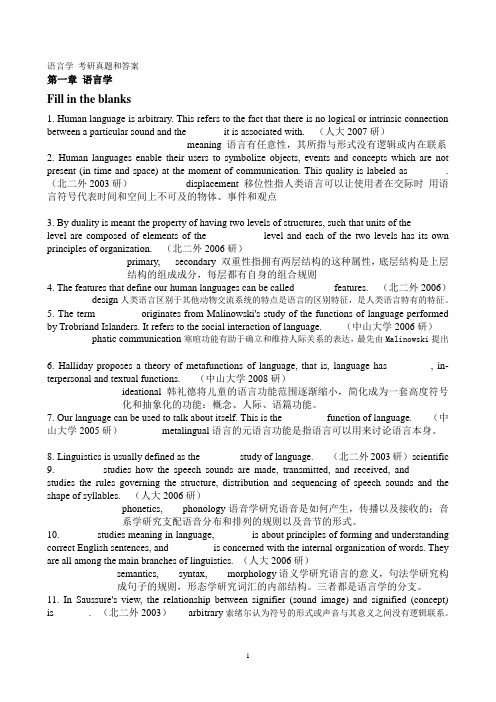
语言学考研真题和答案第一章语言学Fill in the blanks1. Human language is arbitrary. This refers to the fact that there is no logical or intrinsic connection between a particular sound and the _______it is associated with. (人大2007研)meaning 语言有任意性,其所指与形式没有逻辑或内在联系2. Human languages enable their users to symbolize objects, events and concepts which are not present (in time and space) at the moment of communication. This quality is labeled as _______. (北二外2003研)displacement 移位性指人类语言可以让使用者在交际时用语言符号代表时间和空间上不可及的物体、事件和观点3. By duality is meant the property of having two levels of structures, such that units of the _______ level are composed of elements of the __________ level and each of the two levels has its own principles of organization. (北二外2006研)primary, secondary 双重性指拥有两层结构的这种属性,底层结构是上层结构的组成成分,每层都有自身的组合规则4. The features that define our human languages can be called _______ features. (北二外2006)design人类语言区别于其他动物交流系统的特点是语言的区别特征,是人类语言特有的特征。
2022年江苏大学821英语语言学基础与英文写作考研试题和答案分析
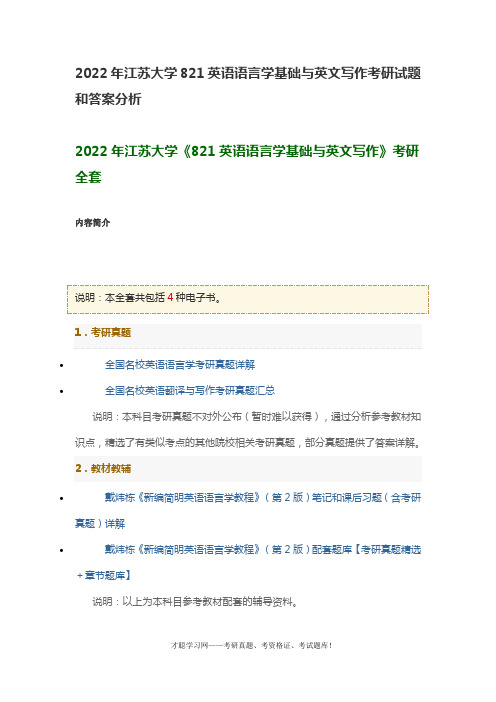
2022年江苏大学821英语语言学基础与英文写作考研试题和答案分析2022年江苏大学《821英语语言学基础与英文写作》考研全套内容简介•全国名校英语语言学考研真题详解•全国名校英语翻译与写作考研真题汇总说明:本科目考研真题不对外公布(暂时难以获得),通过分析参考教材知识点,精选了有类似考点的其他院校相关考研真题,部分真题提供了答案详解。
2.教材教辅•戴炜栋《新编简明英语语言学教程》(第2版)笔记和课后习题(含考研真题)详解•戴炜栋《新编简明英语语言学教程》(第2版)配套题库【考研真题精选+章节题库】说明:以上为本科目参考教材配套的辅导资料。
•试看部分内容第一部分考研真题精选一、选择题1. Derivational morpheme contrasts sharply with inflectional morpheme in that the former changes the _____ while the latter does not.(北二外2017研)A. meaningB. word classC. formD. speech sound【答案】B查看答案【解析】morpheme语素,分为自由语素和黏着语素,其中黏着语素包括词根和词缀两种类型,词缀分为派生词缀(derivational affixes)和屈折词缀(infl ectional affixes)。
派生词缀黏附在词根语素上构成新词,也即增加了新的词汇义内容或改变了词的类别归属。
屈折词缀只能改变一个词的形式,不能构成新词。
也即屈折词缀增加的是表示句法范畴的意义,并且总是不改变词的类别归属。
即两者重要区别在于是否改变了词的类别,故B为正确答案。
2. Which of the following are homographs?(对外经贸2015研)A. lead, leadB. rest, wrestC. lie, lieD. beat, bit【答案】C查看答案【解析】homographs同形异义词,指在语法形式上拼写和发音完全相同,而意义不同的词。
(NEW)中国人民大学外国语学院《816英语语言学与英语教学》历年考研真题及详解
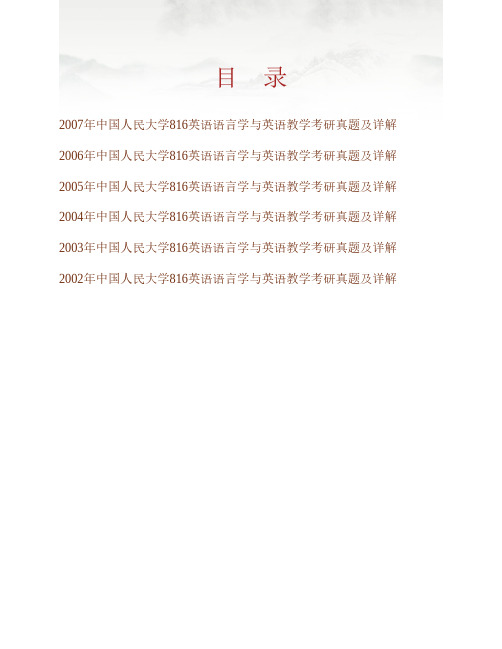
目 录2007年中国人民大学816英语语言学与英语教学考研真题及详解2006年中国人民大学816英语语言学与英语教学考研真题及详解2005年中国人民大学816英语语言学与英语教学考研真题及详解2004年中国人民大学816英语语言学与英语教学考研真题及详解2003年中国人民大学816英语语言学与英语教学考研真题及详解2002年中国人民大学816英语语言学与英语教学考研真题及详解2007年中国人民大学816英语语言学与英语教学考研真题及详解I. Fill in the blanks with the right linguistic concepts (10 points). 1.Human language is arbitrary. This refers to the fact that there is no logical or intrinsic connection between a particular sound and the ______ it is associated with. 2. ______ s a type of word-formation by which a shorter word is coined by the deletion of a supposed affix of a longer form already present in the language. For example,the verb edit was formed from editor by dropping the supposed derivational suffix -or. 3.Some morphemes like –ish,-ness,-ly,-dis,trans-.un- are never words by themselves but are always parts of words. These affixes are ______ morphemes. 4. ______ an be defined as the study of language in use. Sociolinguistics, on the other hand, attempts to show the relationship between language and society. 5. One of the important distinctions in linguistics is ______ and parole. The former is the French word for “language”, which is the abstract knowledge necessary for speaking,listening,writing and reading. The lager is concerned about the actual use of language by people in speech or writing. Parole is more variable and may change according to contextual factors. 6. H.P.Grice believes that there is a set of assumptions guiding the conduct of conversation. This is what he calls the Cooperative Principle. According to the maximum of ______: Do not say what you believe to be false or for which you lack evidence. In other words,speak truthfully; do not lie. 7. ______ proposes that every speaker knows a set of principals which apply to all languages and also a set of parameters that can vary from one language to another, but only within certain limits. 8. ______ refers to varieties of a language used by individual speakers,with peculiarities of pronunciation,grammar and vocabulary. In fact,no two speakers speak exactly the same dialect. Each speaker has certain characteristic features of his own in his way of speaking. 9.According to ______ period hypothesis,in child development there is a period during which language can be acquired more easily than at any other time. The period lasts until puberty (around age 12 or 13 years), and is due to biological development.10. ______ refers to ties and connections which exist within texts. They are also called formal links between sentences and between clauses.答案:I. 1. meaning2.Back-formation3.bound4.Pragmaticsngue6.quality7. Generative Grammar8.Idiolect9.Critical10.CohesionII. Give short answer to the following questions (10 points)I. Explain criterion-referenced and norm-referenced language tests.答案:Tests can be categorized into two major groups: norm-referenced tests and criterion-referenced tests. These two tests differ in their intended purposes, the way in which content is selected, and the scoring process which defines how the test results must be interpreted.A test that measures student knowledge and understanding in relation to specific standards or performance objectives is called criterion-referenced testing (CRT). It measures students’ performance in relation to standards, not in relation to other students; all students may earn the highest grade if all meet the established performance criteria. CRTs report how well students are doing relative to a pre-determined performance level on a specified set of educational goals or outcomes included in the school, district, or state curriculum.A test designed to measure and compare individual students’performances or text results to those of an appropriate peer group (that is,norm group) at the classroom, local or, national level is called norm-referenced testing (NRT). Students with the best performance on a given assessment receive the highest grades. It is generally used to help teachers select students for different ability level reading or mathematics instructional groups.2. Explain the seven types of meaning and use examples to illustrate your ideas.答案:The seven types of meaning were first postulated by G. Leech. They are respectively illustrated as follows:(1) Conceptual meaning, which refers to logical, cognitive, or denotative content. This type of meaning is “denotative” in that it is concerned with the relationship between a word and the thing it denotes, or refers to. It overlaps to a large extent to the concept of reference, but Leech also uses the short form “sense” for the same indication. So Leech’s conceptual meaning contains two parts: sense and reference.(2) Connotative meaning, what is communicated by virtue of what language refers to. It refers to some additional, especially emotive, meaning.(3) Social meaning, referring to what is communicated of the social circumstances of language use.(4) Affective meaning, which refers to what is communicated of the feelings and attitudes of the speaker/writer.(5) Reflected meaning, which refers to what is communicated through association with another sense of the same expression.(6) Collocative meaning, what is communicated through association with words which tend to occur in the environment of another word.The five types of meanings from (2) to (6) are collectively known as Associative meaning in the sense that an elementary associationist theory of mental connections is enough to explain their use.(7) Thematic meaning, what is communicated by the way in which the message is organized in terms of order and emphasis. It is more peripheral since it is only determined by the order of the words in a sentence and the different prominence they each receive.III. Read the following passage carefully and then state your own position concerning the use of knowing some linguistics. (10 points) One famous scholar says that language is an interesting subject to study on its own right, for the simple reason that everybody uses it every day. It is unbelievable that we know very little about something we are so familiar with. Just a few questions will arouse our interest in language. Why should we call the thing we sit on chair? Can’t we call chair table and table chair? How is it that children don’t seem to make a big effort in learning their first language while we adults have to work very hard to learn a second language? Why can we talk about yesterday and last year while cats and dogs never seem to make noises about their past experience? Do you think we can think as clearly without language as with language? Does language determine what we think or thought determines what we say? These questions make us curious about language and linguistics can satisfy our curiosity. To seek the answer to any of these questions is a good reason for studying linguistics.答案:Language is essential to human beings; it plays a central role in our lives as individual and social beings. We have to be fully aware of the nature and mechanism of our language, or we will be ignorant of what constitutes our essential humanity. Therefore, there is every necessity to study language. And Linguistics serves as a way for us to learn more about language, and to explain some phenomena which we have taken granted for but which in fact is quite interesting or puzzling. For example, with the help of linguistics, people could explain why we call the thing we sit on a “chair”but not a “cat” or “dog”, or why we can talk about yesterday and even tomorrow while animals can not. These two kinds of phenomena are all attributed to the design features of language which make it unique from and advantageous over animal languages. The linguists have found that human language is arbitrary because there is no “natural” connection between a linguistic and its meaning. What’s more, human language has also the property of displacement which enables the language users to talk about things and events not present in the immediate environment.Linguistics does not only try to explain the phenomena of language itself, but also try to study the interrelation between it and other aspects of the whole human society. Thus, we have sociolinguistics, which studies the relation of language with society, and which tries to clear out the relationship of language to the society and culture; psycholinguistics, which aims to answer such questions as how the human mind works when we use language, how we as infants acquire our mother tongue, how we memorize, and how we process the information we receive in the course of communication; applied linguistics, which relates some findings in linguistic studies to the solution of such practical problems as the recovery of speech ability, foreignlanguage teachings.Of course, the present linguistic studies can not explain adequately all the phenomena concerned with language, for example, whether it is language determines culture or that culture determines language. Even with the theories which seem to work well on certain aspects of language we should not stay satisfied; for the theory is now accepted as true only because it haven’t been proved wrong.2006年中国人民大学816英语语言学与英语教学考研真题及详解I. Fill in the blanks with the right linguistic concepts (22 points).1. Saussure distinguished the linguistic competence of the speaker and the actual phenomena or data of linguistics (utterances) as (1) and (2) . The former refers to the abstract linguistic system shared by all the members of a speech community, and the latter is the concrete manifestation of language either through speech or through writing.2. (3) grammars attempt to tell what is in the language, while (4) grammars tell people what should be in the language. Most contemporary linguists believe that whatever occurs naturally in the language should be described.3. (5) studies how the speech sounds are made, transmitted, and received, and (6) studies the rules governing the structure, distribution and sequencing of speech sounds and the shape of syllables.4. Words which have different meanings but are written differently and sound alike are called (7) .5. One of the important distinctions in linguistics is (8) and performance.6. There are two fields of morphology: the study of (9) and the study of (10) .7. “The world is like a stage” is an example of (11) , and “All theworld is a stage” is an example o-f (12) . They are often used in analyzing features of literary language.8. (13) studies meaning in language, (14) s about principles of forming and understanding correct English sentences, and (15) is concerned with the internal organization of words. They are all among the main branches of linguistics.9. (16) is the study of the language-processing mechanisms. It is concerned with the storage, comprehension, production and acquisition of language; (17) , on the other hand, attempts to show the relationship between language and society. They both belong to branches of macrolinguistics.10. The part of linguistics that studies the language of literature is called (18) . It focuses on the study of linguistic features related to literary style.11. Children frequently say tooths and mouses, instead of teeth and mice. These are examples of (19) .12. (20) is a relatively complex form of compounding in which a new word is formed by joining the initial part of one word and the final part of another word.For example, the English word smog is made from (21) and (22) .答案:(1) langue (2) parole (3) descriptive (4) prescriptive (5) phonetics(6) phonology (7) homophones (8) competence (9) inflectional (10) lexical/derivational (11) simile (12) metaphor (13) semantics(14) syntax(15) morphology (16) psycholinguistics (17) sociolinguistics (18) stylistics(19) overgeneralization (20) blending (21) smoke (22) fogII. Give brief definitions of the following terms (18 points).1. Phoneme2. CALL3. IC analysis4. Linguistic relativity5. Silent period6. Gradable antonym答案:1. Phoneme. It refers to the abstract element of sound, identified as being distinctive in a particular language. For example, in English, /p/ is described as a phoneme.2. CALL. It is the abbreviation of computer-assisted language learning, which refers to the use of a computer in the teaching or learning of a second or foreign language. In this kind of CALL programs, the computer leads the student through a learning task step-by-step, asking questions to check comprehension. Depending on the student’s response, the computer gives the student further practice or progresses to new material.3. IC analysis. IC analysis (immediate constituent analysis) refers to the analysis of a sentence in terms of its immediate constituents---word groups(orphrases),which are in turn analyzed into the immediate constituents of their own, and the process goes on until the ultimate constituents are reached. In practice, for the sake of convenience, we usually stop at the level of word.4. Linguistic relativity. This is one of two points in Sapir-Whorf hypothesis. It states that similarity between languages is relative, the greater their structural differentiation is, the more diverse their conceptualization of the world is. For example, not every language has the same set of words for the colors; in Spanish there is no word that corresponds to the English meaning of “blue”.5. Silent period. It refers to a period in the initial phase of the language acquisition process, during which children acquiring a new language in natural settings are silent and concentrate on comprehension. And they may respond, if necessary, only in a non-verbal way or by making use of a set of memorized phrases. This phenomenon is also observed when we see how children acquire their mother tongue.6. Gradable antonym. Gradable antonyms are antonyms that are gradable because there are often intermediate forms between the two members of a pair. For example, cold and warm constitute a pair of gradable antonyms.III. Give Short answers to the following questions (40 points):1. In what ways do people cooperate in their conversations?答案:In daily conversations people do not usually say things directly but tend to imply them, and according to Grice, they seem to observe willingly or unwillingly certain principle, which is called “cooperativeprinciple”: “Make your conversational contribution such as is required, at the stage at which it occurs,by the accepted purpose or direction of the talk exchange in which you are engaged”. Under this principle, there are four maxims, namely, Quantity, Quality, Relation, and Manner.2. How is the illocutionary act different from the perlocutionary act?答案:An illocutionary act is the act of expressing the speaker’s intention; it is the act performed in saying something. Thus, if someone says “Morning”, we can ask questions like “What did he mean?” and the answer could be “He offered a greeting.”A perlocutionary act, however, is the effect of the utterance. By telling somebody something the speaker may change the opinion of the hearer on something, or mislead him, or surprise him, or induce him to do something, and so on. Therefore, the perlocutionary act of the saying “Morning” could be to keep friendly relations with the hearer.3. Why did Chomsky make the distinction between deep and Surface structures?答案:In generative grammar, deep structure is the abstract syntactic representation of a sentence, the underlying level of structural organization which specifies all the factors governing the way the sentence should be interpreted. On the other hand, surface structure is the final stage in the syntactic representation of a sentence, which provides the input to the phonological component of the grammar, and which thus most closely corresponds to the structure we articulate and hear.According to Chomsky, it is necessary to make the distinction, since it ishelpful to differentiate and analyze syntactic structures such as “John is easy to please” and “John is eager to please”, and also to disambiguate structures like “the shooting of the hunters”. More importantly, it reflects two of the stages of how the language is processed through the generative grammar: the deep structure, which an underlying structure, has to be transformed to the surface structure via a set of transformational rules.4.What are the major concerns of pragmatics?答案:Pragmatics is the study of the language in use. It is mainly about how speakers use language appropriately and effectively in accordance with a given context. It is concerned with the study of meaning as communicated by a speaker (or writer) and interpreted by a listener (or reader). It has more to do with participants of communication and context in which communication takes place. Hence the study of speaker meaning, that of contextual meaning, of what is unsaid but communicated.5. For the system of transitivity, Halliday identified six kinds of process, each with different types of participants. List four of the processes and comment on the effectiveness of such classification.答案:For the system of transitivity, Halliday has identified six kinds of process, and four of them are material process, relational process, behavioral process, and mental process.Such a classification has a lot to do with the systemic-functional approach of grammar interpretation. The classification of the system of transitivity helps reveal the functions of the components in relation to the whole clause; it is an interpretation of grammar in terms of ideationalfunction. These six types of process have divided up the semantic system of ideational function, by showing the various ways of language to react on the material world around us, and make sense of their experience of what goes on around them and inside them, or in other words, to perform the ideational function.IV. Answer the following questions, citing examples to support your ideas (40 points).1. What are the seven functions of human language?答案:According to Hu Zhuanglin, language has at least seven functions, and they are illustrated as follows:1) Informative function. It means that language is the instrument of thought and language serves an informational function when used to tell something. It is also called ideational function in the framework of functional grammar. The declarative sentences such as “This is a book.” are the typical illustration of this function.2) Interpersonal function. The interpersonal function means people can use language to establish and maintain their status in a society. It is the most important sociological use of language. In the framework of functional grammar, this function is concerned with interaction between the addresser and addressee in the discourse situation and the addresser's attitude toward what he speaks or writes about. For example, the ways in which people address others and refer to themselves (such as Dear Sir, Dear Professor, Johnny, yours, your obedient servant) indicate the various grades of interpersonal relations.3) Performative function. The performative function of language is primarily to change the social status of persons, as in marriage ceremonies, the sentencing of criminals, the blessing of children, the naming of a ship at a launching ceremony, and the cursing of enemies. The kind of language employed in performative verbal acts is usually quite formal and even ritualized. The performative function can extend to the control of reality as on some magical or religious occasions. For example, in Chinese when someone breaks a bowl or a plate the host or the people present are likely to say sui sui ping an (every year be safe and happy) as a means of controlling the forces which the believers feel might affect their lives.4) Emotive function. The emotive function is one of the most powerful uses of language because it is so crucial in changing the emotional status of an audience for or against someone or something. It is a means of getting rid of the nervous energy when people are under stress, for example, swear words, obscenities, involuntary verbal reactions to beautiful art or scenery; conventional words/phrases, for example. God, My, Damn it, Wow, Ugh, Ow, etc.5) Phatic communion. The phatic communion refers to the social interaction of language. People always use some small, seemingly meaningless expressions such as Good morning, God bless you, Nice day, etc., to maintain a comfortable relationship between people without any factual content.6) Recreational function. The recreational function means people use language for the sheer joy of using it, such as a baby’s babbling or a chanter’s chanting.7) Metalingual function. The metalingual function refers to the fact that people can use language to talk about itself. For example, I can use the word “book” to talk about a book, and I can also use the expression “the word book” to talk about the sign “b-o-o-k” itself.2. What are the major types of semantic Changes?答案:There are mainly three kinds of semantic changes, namely, broadening, narrowing, and meaning shift. Class shift and folk etymology also contribute to change in meaning (1) BroadeningBroadening is a process to extend or elevate the meaning from its originally specific sense to a relatively general one.For instance,the word holiday used to mean“holy day”in religious English. Today it means“a day for rest”regardless of its religious nature.(2) NarrowingContrary to broadening,the original meaning of a word can be narrowed or restricted to a specific sense.A typical example is the word meat which originally meant "food". In the course of time, the range of meaning was narrowed to mean specifically "the flesh of animals used as food".(3) Meaning shiftAll semantic changes involve meaning shift.Yet, in its narrow sense, meaning shift refers to the change of meaning, which has nothing to do with generalization or restriction. What makes the meaning of a word different isits departure from its original domain as a result of its metaphorical usage. For instance,the word bead originally means “prayer”, but later it refers to “the prayer bead”, the visible manifestation of a prayer, finally “small, ball-shaped piece of glass, metal or wood”.(4) Class shiftBy shifting the word class one can change the meaning of a word from a concrete entity or notion to a process or attribution. This process of word formation is also known as zero-derivation, or conversion. The word engineer as a noun means “a person trained in a branch of engineering”, but it means “to act as an engineer” or “to plan, to maneuver” when used as a verb.(5) Folk etymologyIt refers to a change in form of a word or phrase resulting from an incorrect popular notion of the origin or meaning of the term or from the influence of more familiar terms mistakenly taken to be analogous. As a result of this modification,the word sparrowgrass in English derived from asparagus; the Spanish cucaracha changed into English cockroach.V. Translate the following into Chinese (30 points). Suppose that John Smith, happily married to Mary Smith, addresses his wife as “Mary, Smith, how many times have I asked you not to flip through the TV channels?” There would be reason to took beyond the words for the “meaning” of this unusual form of address. Mr. Smith may address his wife as “Mary Smith” to show his exasperation, as in this example. By addressing her as “Mary Smith” instead of the usual “Mary”, he conveys frustration and annoyance. His choice of name thus “means” that he is exasperated. Contrast the tone of that Sentence With a similar one in whichJohn Smith addressed Mary Smith as “dear”. The level of meaning that conveys the language user’s feelings, including his attitude or evaluation in shaping his use of language is Called affective meaning or emotive meaning. It is largely a parasitic category in the sense that to express our emotions we depend on the mediation of other categories of meaning as conceptual, connotative or social. For example, nigger, originally a word denoting a certain race, has virtually become a term of abuse or contempt; and a similar development has occurred with part of the political vocabulary, such as fascist.【参考译文】假设约翰·史密斯开心地娶了玛丽小姐后却这样称呼他的妻子:“玛丽·史密斯,我告诉过你多少次了,换台时不要老那么快!”撇开字面意思,这不寻常的称呼的出现是有理由的。
2022年东北师范大学英语专业基础语言学考研真题和答案
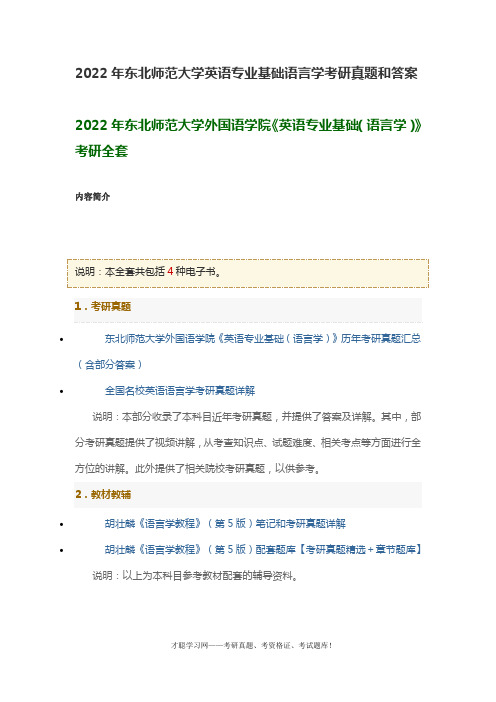
2022年东北师范大学英语专业基础语言学考研真题和答案2022年东北师范大学外国语学院《英语专业基础(语言学)》考研全套内容简介•东北师范大学外国语学院《英语专业基础(语言学)》历年考研真题汇总(含部分答案)•全国名校英语语言学考研真题详解说明:本部分收录了本科目近年考研真题,并提供了答案及详解。
其中,部分考研真题提供了视频讲解,从考查知识点、试题难度、相关考点等方面进行全方位的讲解。
此外提供了相关院校考研真题,以供参考。
2.教材教辅•胡壮麟《语言学教程》(第5版)笔记和考研真题详解•胡壮麟《语言学教程》(第5版)配套题库【考研真题精选+章节题库】说明:以上为本科目参考教材配套的辅导资料。
•试看部分内容第一部分考研真题精选一、填空题1. Ch o m s ky p ro po se s th at th e co u r se o f l an gu age a cquisition is determined by a(n) _____language faculty.(中山大学2018研)【答案】innate查看答案【解析】乔姆斯基认为语言习得的过程是由人的内在语言机制决定的。
2. _____ refers to the role language plays in communicati o n(e.g. to e x pre ss i de as, at ti tu de s) o r i n parti cu l a r social situations (e.g. Religious, legal).(北二外2016研)【答案】Fun ctio n查看答案【解析】本题考查语言学中对“语言的功能”的定义。
功能指的是语言在沟通中(例如表达观点、态度)或在特定社交场合(如宗教、法律)中所起的作用。
3. Hum an langu age is arbi trary. Thi s re fe rs to the f actth at th e re i s no l o gi cal o r i n tri n si c con ne cti on be tween a particul ar so un d an d the _____i t i s asso ci ate d wi t h.(人大2007研)【答案】me aning查看答案【解析】索绪尔认为符号的形式或声音与其意义之间没有逻辑联系,所以两者之间的关系是任意的。
考研《706外语(英)水平考试》暨南大学考研真题解析
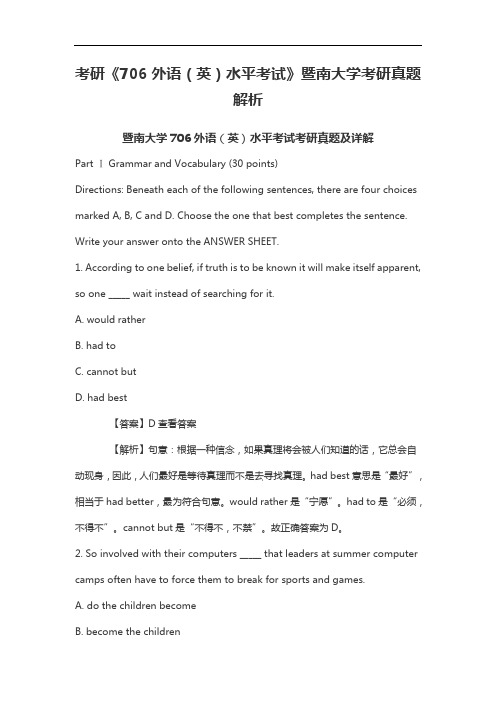
考研《706外语(英)水平考试》暨南大学考研真题解析暨南大学706外语(英)水平考试考研真题及详解Part Ⅰ Grammar and Vocabulary (30 points)Directions: Beneath each of the following sentences, there are four choices marked A, B, C and D. Choose the one that best completes the sentence. Write your answer onto the ANSWER SHEET.1. According to one belief, if truth is to be known it will make itself apparent, so one _____ wait instead of searching for it.A. would ratherB. had toC. cannot butD. had best【答案】D查看答案【解析】句意:根据一种信念,如果真理将会被人们知道的话,它总会自动现身,因此,人们最好是等待真理而不是去寻找真理。
had best意思是“最好”,相当于had better,最为符合句意。
would rather是“宁愿”。
had to是“必须,不得不”。
cannot but是“不得不,不禁”。
故正确答案为D。
2. So involved with their computers _____ that leaders at summer computer camps often have to force them to break for sports and games.A. do the children becomeB. become the childrenC. had the children becomeD. became the children【答案】C查看答案【解析】句意:孩子们如此沉迷于电脑,以至于夏令营的电脑领导者常常不得不强迫他们停下来做运动和游戏。
(NEW)暨南大学外国语学院808外国语言文学综合考试历年考研真题及详解
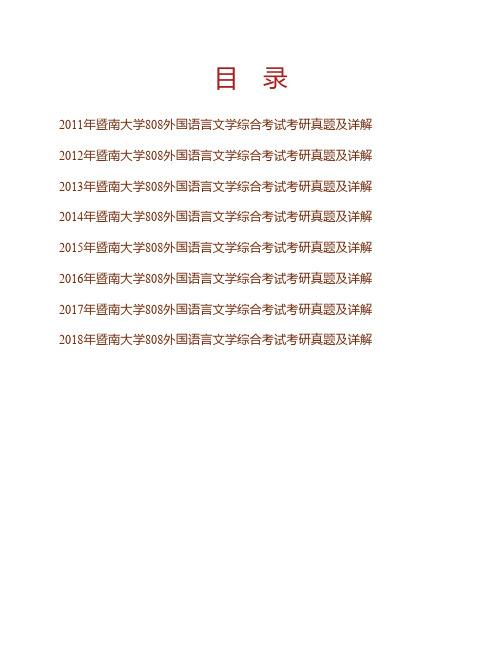
目 录2011年暨南大学808外国语言文学综合考试考研真题及详解2012年暨南大学808外国语言文学综合考试考研真题及详解2013年暨南大学808外国语言文学综合考试考研真题及详解2014年暨南大学808外国语言文学综合考试考研真题及详解2015年暨南大学808外国语言文学综合考试考研真题及详解2016年暨南大学808外国语言文学综合考试考研真题及详解2017年暨南大学808外国语言文学综合考试考研真题及详解2018年暨南大学808外国语言文学综合考试考研真题及详解2011年暨南大学808外国语言文学综合考试考研真题及详解SECTION AⅠ. Fill the blanks with proper answers (10%)1. The English sonnet, also known as _____ sonnet, usually has a regular rhyme scheme a-b-a-b, c-d-c-d, e-f-e-f, g-g.【答案】Shakespearean【解析】莎士比亚的诗作,改变了彼得拉克的格式,由三段四行和一副对句组成,即按四、四、四、二编排,其押韵格式为“ABAB,CDCD,EFEF,GG”。
每行诗句有十个抑扬格音节。
2. It was in 1798, with the publication of William Wordsworth’s _____, in collaboration with S.T. Coleridge, that romanticism began to bloom and found a firm place in the history of English literature.【答案】Lyrical Ballads1798年,华兹华斯与柯勒律治将各自的诗歌合为一册,定【解析】名为《抒情歌谣集》。
3. The typical feature of Robert Browning’s poetry is the _____.【答案】dramatic monologue【解析】勃朗宁对英国诗歌的最大贡献,是发展和完善了戏剧独白诗这样一种独特的诗歌形式,并且用它鲜明而生动地塑造了各种不同类型的人物性格,深刻而复杂地展示了人的内在心理。
四川师范大学824外国语言文学综合英语考研真题详解
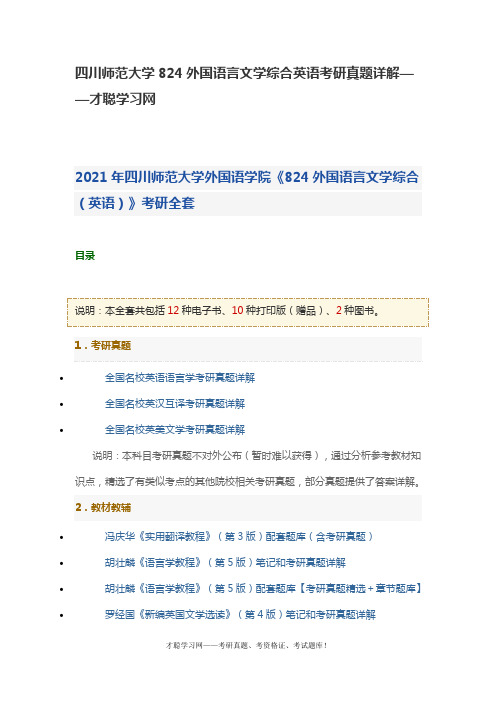
四川师范大学824外国语言文学综合英语考研真题详解——才聪学习网2021年四川师范大学外国语学院《824外国语言文学综合(英语)》考研全套目录•全国名校英语语言学考研真题详解•全国名校英汉互译考研真题详解•全国名校英美文学考研真题详解说明:本科目考研真题不对外公布(暂时难以获得),通过分析参考教材知识点,精选了有类似考点的其他院校相关考研真题,部分真题提供了答案详解。
2.教材教辅•冯庆华《实用翻译教程》(第3版)配套题库(含考研真题)•胡壮麟《语言学教程》(第5版)笔记和考研真题详解•胡壮麟《语言学教程》(第5版)配套题库【考研真题精选+章节题库】•罗经国《新编英国文学选读》(第4版)笔记和考研真题详解•罗经国《新编英国文学选读》(第4版)配套题库【考研真题精选+章节题库】•陶洁《美国文学选读》(第3版)笔记和课后习题(含考研真题)详解•[预售]陶洁《美国文学选读》(第3版)配套题库【考研真题精选+章节题库】•王佐良《欧洲文化入门》笔记和课后习题详解•王佐良《欧洲文化入门》配套题库(含考研真题)说明:以上为本科目参考教材配套的辅导资料。
•试看部分内容考研真题精选一、填空题1. Ch o m s ky p ro po se s th at th e co u r se o f l an gu age a cquisition is determined by a(n) _____language faculty.(中山大学2018研)【答案】innate查看答案【解析】乔姆斯基认为语言习得的过程是由人的内在语言机制决定的。
2. _____ refers to the role language plays in communic ati o n(e.g. to e x pre ss i de as, at ti tu de s) o r i n parti cu l a r social situations (e.g. Religious, legal).(北二外2016研)【答案】Fun ctio n查看答案【解析】本题考查语言学中对“语言的功能”的定义。
北京师范大学942英语语言学及应用语言学考研真题及解析

北京师范大学考研历年真题解析——942英语语言学及应用语言学主编:弘毅考研编者:kittyli弘毅教育出品目录北师大2013年考研真题解析 (5)北师大2012年考研真题解析............................. 错误!未定义书签。
北师大2008年考研真题解析............................. 错误!未定义书签。
北师大2007年考研真题解析............................. 错误!未定义书签。
北师大2006年考研真题解析............................. 错误!未定义书签。
北师大2005年考研真题解析............................. 错误!未定义书签。
北师大2004年考研真题解析............................. 错误!未定义书签。
北师大2003年考研真题解析............................. 错误!未定义书签。
大家在做题目之前要先看一下试卷的整体情况,以及每个题目的分值情况,因为有时候分值的情况有可能会影响到你们答题的情况。
例如如果一道题的分值不是很多,是1分或2分,则解释下概念即可,如果分值较高,那么可能稍作解释,提供例子。
还有语言学的答题是很客观的一个过程,看到一个概念或理论,你只需要把你记得的书上的内容写下来就好了,不要加上自己的想法和观点,当然问你自己的看法和观点的题目除外。
北师大2013年考研真题解析1.(1) T-unit refers to a main clause plus any subordinate clauses that may be attached to it. The T-unit was intended to measure the smallest word group that could be considered a grammatical sentence, regardless of how it was punctuated. Research suggests that the length of a T-unit may be used as an index of syntactic complexity.(2) Our language helps mould our way of thinking and, consequently, different languages may probably express speakers’ unique ways of understanding the world. Two important points can be captured in this theory. ①Language may determine our thinking patterns; ②Similarity between languages is relative. For two different speech communities, the greater their structural differentiation is, the more diverse their conceptualization of the world will be. For this reason, this hypothesis has alternatively been referred to as LINGUISTIC DETERMINISM and LINGUISTIC RELATIVITY. What this hypothesis primarily suggests is that our language will mould our view of the world.(3) validity refers to the extent to which a test measures what it is supposed to measure and nothing else. If a test is valid, it is a true reflection of the individual’s skill. Content validity involves the judgements of professionals regarding whether a test covers what it should cover.(4) Curriculum development refers to the range of planning and implementation processes involved in developing or renewing a curriculum. These processes focus on needs analysis, situational analysis, planning learning outcomes, course organization, selecting and preparing teachingmaterials, providing for effective teaching and evaluation.(5) Foregrounding is defined as “artistically motivated deviation”. This deviation, or uncommon usage, involves all levels of language: vocabulary, sound, syntax, meaning, graphology, etc. Repetition is also a kind of deviation as it violates the normal rules of usage by over-frequency. Repetitive patterns are superimposed on the background of expectations of normal usage and so strike the reader’s attention as unusual. Alliteration, parallelism, and many figures of speech or schemes involving repetition of lexical terms are thus commonly exploited in foregrounding in literary language.2. Malinowski’s theories:。
考研语言学解析真题及答案

考研语言学解析真题及答案语言学是一门研究语言的学科,涵盖广泛且深入的内容。
对于考研生而言,语言学是考试中非常重要的一部分。
在考试中,解析真题并掌握答案是提高分数的关键。
本文将对进行探讨,帮助考生更好地备考。
首先,我们来看一个例子:“人类的语言活动是指以语言为工具,进行思维交流、情感表达、信息传递、文化传承等的行为。
”这个例子涉及到了语言的定义和功能。
在解析这类题目时,我们需要明确的是语言的本质和意义。
语言是人类特有的交流工具,通过语言人们能够传递信息、表达思想、交流感情等。
语言的功能多样,它不仅是思维和交流的工具,还是文化传承的载体。
其次,我们来看一个与语言现象相关的例子:“单词的概念具有导言性的特征,即单词在实际运用中具有不同的意义。
”这个例子涉及到了词汇的导言性。
解析这类题目时,我们需要了解词汇的导言性是什么意思。
导言性是指词汇在不同的语境中具有不同的意义。
同一个词汇在不同的句子中可能具有不同的含义,需要根据具体语境来确定词汇的意义。
导言性是词汇意义的重要特征,它使得语言能够更准确地表达思想和交流信息。
接下来,我们看一个与语音学相关的例子:“声音是语言的基本要素,不同的语言使用不同的语音来表达意思。
”这个例子涉及到了语言的声音特征。
在解析这类题目时,我们需要了解语音学的基本概念。
语音学是研究语音现象的学科,它研究的对象是语音的产生、传播和接收。
语音是语言的基本要素,通过不同的语音单元可以组成不同的词汇和句子,进而表达不同的意思。
最后,我们来看一个与语言变化相关的例子:“语言的变化是一种历史现象,不同的时期和地区语言会发生变化。
”这个例子涉及到了语言变化的概念。
解析这类题目时,我们需要了解语言变化的原因和过程。
语言变化是一种历史现象,它受到社会和文化等多种因素的影响。
不同的时期和地区,语言会发生变化,包括词汇的增减、语法结构的演变等。
了解语言变化的规律可以帮助我们更好地理解语言的发展和变化。
通过以上的例子,我们可以看出,语言学是一门琳琅满目的学科,涉及到语言的各个方面。
2015年中国人民大学英语语言学考研真题分析

2015年中国人民大学英语语言学考研真题分析语言学题目都比较基础一、15*2=30填空二、10*4=40问答1、open class w ords和closed class w ords2、pidgin and creole3、high variety和low variety4、language family三、40给定材料进行论述关于语法和语用学的不同代表人物不同的研究方法四、40汉译英关于传统语法和描写性语法的注意事项:(一)与学校联系,确定具体的学校、专业,获得具体的考试信息如果确定了要考研,确定了要报考的大致学校和专业范围后,要和学校联系,获得最新的招生信息,并最后确定下报考的学校和专业。
这种获得有关专业方面信息的途径有以下几个:1、招生简章。
一般在7-8月份出,由各个学校的研究生招生主管部门(研究生院和研究生处)公布。
上面会列出:招生单位名称、代码、通讯地址、邮政编码、联系电话;招生的专业人数(有的以系、所、院、中心等整个具体招生单位为单位,有的具体到每一个专业);导师(有的不刊登,多属于集体培养);有的还会列出委培、自费等人数,但保送、保留学籍的名额一般不列出来(但这对于考生确实是非常关键的信息);考试科目;使用的参考书(很多学校也不列出,即使列出,经常列出的书目大多,或太少)。
因此可以看出,大部分招生单位的招生简章上的信息对于考生是远远不够的,这些可以说都是最基本的信息,而关键的信息,却没有列出。
2、系办印发的说明和专业课试题集。
为了弥补招生简章的不足,应付考生不停地打电话询问一些有关信息,有的招生单位(一般都是具体的招生单位如系、院、所和中心等)特别公布一些说明,比如:历年报名人数、录取人数、录取比例、录取分数、参考书目等等,但保送人数、保留学籍人数仍无法公布,因为他们一般要到11月份研究生报名之前左右才能确定。
如果系里能公布最近几年的专业课试卷,那对于考生是莫大的福音了,要是没有看到以前的这些试题,复习准备无异是盲人摸象。
北交大03-15年英语语言学考研解答题汇总
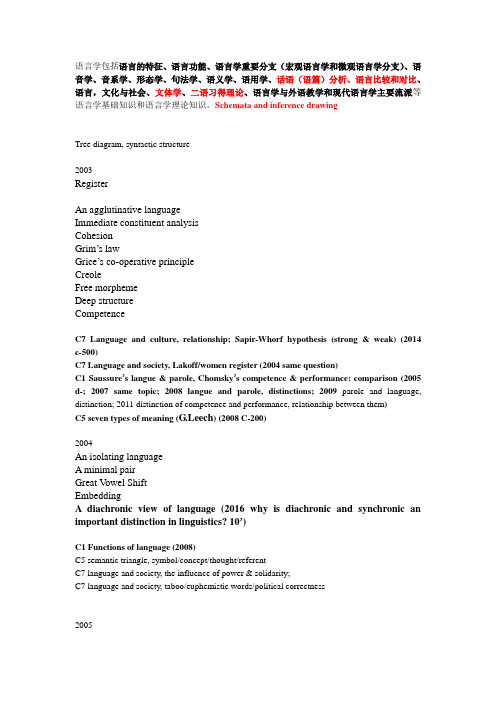
语言学包括语言的特征、语言功能、语言学重要分支(宏观语言学和微观语言学分支)、语音学、音系学、形态学、句法学、语义学、语用学、话语(语篇)分析、语言比较和对比、语言,文化与社会、文体学、二语习得理论、语言学与外语教学和现代语言学主要流派等语言学基础知识和语言学理论知识。
Schemata and inference drawingTree diagram, syntactic structure2003RegisterAn agglutinative languageImmediate constituent analysisCohesionGrim’s lawGrice’s co-operative principleCreoleFree morphemeDeep structureCompetenceC7 Language and culture, relationship; Sapir-Whorf hypothesis (strong & weak) (2014 c-500)C7 Language and society, Lakoff/women register (2004 same question)C1 Saussure’s langue & parole, Chomsky’s competence & performance: comparison (2005 d-; 2007 same topic; 2008 langue and parole, distinctions; 2009 parole and language, distinction; 2011 distinction of competence and performance, relationship between them)C5 seven types of meaning (G.Leech) (2008 C-200)2004An isolating languageA minimal pairGreat V owel ShiftEmbeddingA diachronic view of language (2016 why is diachronic and synchronic an important distinction in linguistics? 10’)C1 Functions of language (2008)C5 semantic triangle, symbol/concept/thought/referentC7 language and society, the influence of power & solidarity;C7 language and society, taboo/euphemistic words/political correctness2005DualityLangue and paroleC2 p45 Distinctive features (2008 C-100)Paradigmatic relations (also called associative relation by Saussure)Speech act theorySelection restrictionsC8 p181 characteristics of implicature (2007 d-/2009 the theory of it/2014 c-300/2016术语) C12 the three important points of the Prague School (P16 Spark)C8 the theory of the illocutionary act (2009 C-100/2011C-100)C5 the referential theory of meaning (2008 same)C5 Componential analysis, advantages and disadvanges (2007 advantages/2009 c-100/2013 weaknesses)C1 communicative competenceC7 Language and society, Lakoff/you are what you say2006DisplacementCompetence and performanceMetalingual function of languageEtic and emicEnocentric and exocentric constructionsC4 IC analysis, advantages and disadvangesC12 systemic-functional grammar (2007/2008/2011)C5 logical semanticsC11 input hypothesis and language learning2007Foregrounding (2010 c-200)Conversational implicatureAllophoneMetalinguistic function (Metalingual function?)Creativity as a property of languageC2 distinctive feature, definitionC5 Componential analysis, advantages (2005)C4 endocentric and exocentric constructions, definition (2013 endocentric c-200)C12 systemic-functional grammar (2006)C8 relevance theory and Grice’s cooperative principleC1 Saussure’s langue & parole, Chomsky’s competence & performance: comparison—similarities and differences (2003)2008ArbitrarinessAnthropological linguistics (2016)Bound morphemeParadigmatic relation (2005)Halliday’s material process in systemic functional grammarC1 Functions of language (2004)C1 langue and parole, distinctionsC5 the referential theory of meaning (2008)C2 p45 Distinctive features (2005-d)C5 seven types of meaning (G.Leech) (2003)C7 Language and society, relationshipC12 American structuralism (2010 c-100): is a branch of synchronic linguistics that emerged in the United States at the beginning of the twentieth century. (2016 what is the structural approach to the analysis of language? Please explain with examples)2009Arbitrariness at the syntactic level (2008单考anbitrariness/2011/2012the design features/2016)MacrolinguisticsForegrounding and grammatical form (2007)Gradable antonymyMinimal pairsC8 the theory of the illocutionary act (2005)Felicity conditionsC5 Componential analysis (2005 advantages and disadvanges/2007 advantages)C12 the London School in linguistics (2012 c-100)C8 p181 the theory of implicature (2007 d-/2005 characteristics): Laurence HornLinguistic relativityC1 Language and parole, distinction (2003 Saussure’s langue & parole, Chomsky’s competence & performance: comparison/2005 d-/2007 same to 2003/2008 langue and parole, distinctions)2010C2 P24 Acoustic phoneticsC2 P37 Co-articulationC2 P41 Free variation (in phonology)C5 Affective meaning (as is defined by G.Leech)C3 P54 Derivational affixPhoneme theory (2016 what is the phoneme theory? 10’)C5 the integrated theory of meaning (2011 adcantages and disadvantages)Context of situation (2016 general context effect and specific context effect)C12 American structuralism (2008 c-200)C7 sociolinguistics and foreign language teaching, implicationC9 foregrounding and literature study (2007)2011C1 Arbitrariness at the syntactic level (2009/2008)C1 Emotive function of languageC1 Computational linguisticsC2 Minimal pairs (in phonology)C11 Interlanguage P254 (2014 its functions): the type of language constructed by second or foreign language learners who are still in the process of learning a language.C1 distinction of competence and performance, relationship between them (2003 Saussure’s langue & parole, Chomsky’s competence & performance: comparison (2005 d-; 2007 same topic; 2008 langue and parole, distinctions; 2009 parole and language, distinction)C11 requirements of a good test (2016 aptitude test 术语)C8 a theory of the illocutionary act (2009 C-100/2005C-100)C12 Halliday functions and structure/c-150 system relationship/the specialty of systemic-functional linguistics (2006/2007/2008)C5 the integrated theory of meaning, advantages and disadvantages (2010)2012C1 The design features of language: arbitrariness, duality, creativity (productivity), displacementC1 Textual function of language P10C12 Functional sentence perspective: FSP, Prague School, theme, rhymeC8 Illocutionary force: extra meaning of the utterances or written text言外之意p175C8 The relevance theory: Sperber and Wilson (2013/2015 c-350)C1 Micro-linguistics and macro-linguisticsC1 the reason why competence and performance an important distinction (2003 Saussure’s langue & parole, Chomsky’s competence & performance: comparison (2005 d-; 2007 same topic; 2008 langue and parole, distinctions; 2009 parole and language, distinction; 2011 distinction of competence and performance, relationship between them)C12 the London School (2009 same)C12 functionalism in linguistics2013 (《语法讲义》朱德熙)C1 The pooh-pooh theory of origin of language (2016)C3 Bound morphemesC1 Informative function of languageC6 Cognitive linguisticsC8 Sperber and Wilson’s relevance theory (2012)C2 Suprasegmental features and their functionsC1 Jakobson’s view of the functions of language (2015 C-300)C4 endocentric constrution c-200 (2007 endocentric and exocentric constructions, definition) C5 Componential analysis, weaknesses (2005 advantages and disadvanges/2007 advantages/2009 c-100)C12 c1500 functional sentence perspectiveFirth’s theory of language2014C1 Duality (2005)C1/C2 Phonology [minimal pairs, free variation]C1 Computational linguistics (2011)C2 A minimal pair (2004/2005/2009/2011)C4 Horizontal relations (or syntactic relations) [Arbitrariness at the syntactic levelC-300C8 p181 characteristics of implicature (2005/2007 d-/2009 the theory of it)C11 functions of inter-language (2001 d-)C4 tree diagram, examplesc-500C9 Sapir-Whorf hypothesis (strong & weak) (2003)C8 post-Gricean developments in pragatics2015C5 PresuppositionC3 Free and bound morphemes (2013/2008/2003)C12 The innateness hypothesisC1 Competence and performance (2006/2003)C9 Text styleC1 Jakobson’s view of the functions of language (2013 C-300)C9 definition, features and effects of free direct thoughtC-350C8 The relevance theory: Sperber and Wilson (2012/2013) Schemata and inference drawing。
(完整版)英语语言学考研真题与典型题详解1
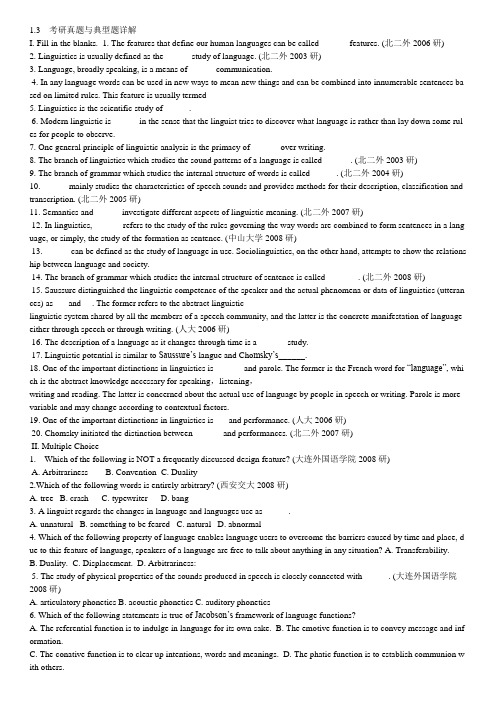
1.3考研真题与典型题详解I. Fill in the blanks. 1. The features that define our human languages can be called ______ features. (北二外2006研)2. Linguistics is usually defined as the ______study of language. (北二外2003研)3. Language, broadly speaking, is a means of______ communication.4. In any language words can be used in new ways to mean new things and can be combined into innumerable sentences ba sed on limited rules. This feature is usually termed______5. Linguistics is the scientific study of______.6. Modern linguistic is______ in the sense that the linguist tries to discover what language is rather than lay down some rul es for people to observe.7. One general principle of linguistic analysis is the primacy of ______ over writing.8. The branch of linguistics which studies the sound patterns of a language is called ______. (北二外2003研)9. The branch of grammar which studies the internal structure of words is called______. (北二外2004研)10. ______mainly studies the characteristics of speech sounds and provides methods for their description, classification and transcription. (北二外2005研)11. Semantics and ______investigate different aspects of linguistic meaning. (北二外2007研)12. In linguistics, ______ refers to the study of the rules governing the way words are combined to form sentences in a lang uage, or simply, the study of the formation as sentence. (中山大学2008研)13. ______can be defined as the study of language in use. Sociolinguistics, on the other hand, attempts to show the relations hip between language and society.14. The branch of grammar which studies the internal structure of sentence is called _______. (北二外2008研)15. Saussure distinguished the linguistic competence of the speaker and the actual phenomena or data of linguistics (utteran ces) as and . The former refers to the abstract linguisticlinguistic system shared by all the members of a speech community, and the latter is the concrete manifestation of language either through speech or through writing. (人大2006研)16. The description of a language as it changes through time is a ______ study.17. Linguistic potential is similar to Saussure’s langue and Cho msky’s______.18. One of the important distinctions in linguistics is ______ and parole. The former is the French word for “language”, whi ch is the abstract knowledge necessary for speaking,listening,writing and reading. The latter is concerned about the actual use of language by people in speech or writing. Parole is more variable and may change according to contextual factors.19. One of the important distinctions in linguistics is and performance. (人大2006研)20. Chomsky initiated the distinction between ______ and performances. (北二外2007研)II. Multiple Choice1.Which of the following is NOT a frequently discussed design feature? (大连外国语学院2008研)A. ArbitrarinessB. ConventionC. Duality2.Which of the following words is entirely arbitrary? (西安交大2008研)A. treeB. crashC. typewriterD. bang3. A linguist regards the changes in language and languages use as______.A. unnaturalB. something to be fearedC. naturalD. abnormal4. Which of the following property of language enables language users to overcome the barriers caused by time and place, d ue to this feature of language, speakers of a language are free to talk about anything in any situation? A. Transferability.B. Duality.C. Displacement.D. Arbitrariness:5. The study of physical properties of the sounds produced in speech is closely connected with______. (大连外国语学院2008研)A. articulatory phoneticsB. acoustic phoneticsC. auditory phonetics6. Which of the following statements is true of Jacobson’s framework of language functions?A. The referential function is to indulge in language for its own sake.B. The emotive function is to convey message and inf ormation.C. The conative function is to clear up intentions, words and meanings.D. The phatic function is to establish communion w ith others.7.Which of the following is a main branch of linguistics? (大连外国语学院2008研)A. MacrolinguisticsB. PsycholinguisticsC. Sociolinguistics8. ______ refers to the system of a language, i. e. the arrangement of sounds and words which speakers of a language have a shared knowledge of. (西安外国语学院2006研)A. LangueB. CompetenceC. Communicative competenceD. Linguistic potential9.The study of language at one point in time is a _______ study. (北二外2010研)A. historicalB. synchronicC. descriptiveD. diachronic10. “An refer to Confucius even though he was dead 2,000 years ago. ” This shows that language has the design feature of _ ____.A. arbitrarinessB. creativityC. dualityD. displacement11. The function of the sentence “Water boils at 100 degree Centigrade” is .A. interrogativeB. directiveC. informativeD. performative 12.Saussure is closely connected with______. (大连外国语学院2008研) A. Langue B. Competence C. EticIII. True or False1. Onomatopoeic words can show the arbitrary nature of language. (清华2000研)2. Competence and performance refer respectively to a language user’s underlying knowledge about the system of rules and the actual use of language in concrete situations.3. Language is a means of verbal communication. Therefore, the communication way used by the deaf-mute is not language4. Arbitrariness of language makes it potentially creative, and conventionality of language makes a language be passed from generation to generation. As a foreign language learner, the latter is mere important for us.5. The features that define our human languages can be called DESIGN FEATURES. (大连外国语学院2008研)6. By diachronic study we mean to study the changes and development of language.7. Langue is relatively stable and systematic while parole is subject to personal and situational constraints.8. Language change is universal, ongoing and arbitrary.9. In language classrooms nowadays the grammar taught to students is basically descriptive, and more attention is paid to the developing learners’ communicative skills.10. Language is a system of arbitrary, written signs which permit all the people in a given culture, or other people who have learned the system of that culture, to communicate or interact.11. Saussure’s exposition of synchronic analysis led to the school of historical linguistics.12. Applied linguistics is the application of linguistic principles and theories to language teaching and learning.13. Wherever humans exist, language exists. (对外经贸2006研)14. Historical linguistics equals to the study of synchronic study.15. Duality is one of the characteristics of human language. It refers to the fact that language has two levels of structures: the system of sounds and the system of meanings.16. Prescriptive linguistics is more popular than descriptive linguistics, because it can tell us how to speak correct language. IV. Explain the following terms.1.Duality (北二外2010研;南开大学2010研)2.Design featurespetence4.Displacement (南开大学2010研;清华2001研)5.Diachronic linguistics6. Descriptive linguistics7.Arbitrariness(四川大学2006研)V. Short answer questions1. Briefly explain what phonetics and phonology are concerned with and what kind of relationships hold between the two. (北外2002研)参考答案及解析I.Fill in the blanks.1.Design (人类语言区别于其他动物交流系统的特点是语言的区别特征,是人类语言特有的特征。
南京大学外国语学院《963英语语言学》历年考研真题及详解专业课考试试题

目 录2014年南京大学963英语语言学考研真题(回忆版)2013年南京大学963英语语言学考研真题(回忆版)2012年南京大学963英语语言学考研真题(回忆版)2009年南京大学963英语语言学考研真题及详解2008年南京大学963英语语言学考研真题及详解2007年南京大学463英语语言学考研真题及详解2006年南京大学463英语语言学考研真题及详解2003年南京大学英语语言学考研真题2002年南京大学英语语言学考研真题2001年南京大学英语语言学考研真题2000年南京大学英语语言学考研真题2014年南京大学963英语语言学考研真题(回忆版)第一题,术语区分题。
四组术语,24分。
1.phoneme vs. allophone2.homonymy vs. homophony3.illocutionary act vs. perlocutionary actnguage switch vs. L1 transfer第二题,选择题,考察的都是基础知识,10小题,共30分。
第三题,分析题。
给出几个句子,要求先填写名词前的冠词或复数后缀-s;然后总结出使用冠词或复数后缀-s的一般模式(common pattern)。
第四题,分析题,考察的知识点是歧义(ambiguity)。
给出两句话,要求先回答这两句话有无歧义,并写出每句话的不同理解,再分析这两句话产生歧义的原因是否相同。
1.The children play near the bank.2. The professor said on Monday that he would give an exam.显然,第一句话中的bank涉及lexical ambiguity, 而第二句话中的on Monday既可修饰said,又可修饰would give an exam,属于grammatical/structural ambiguity。
第五题,分析题,考察隐喻。
【优质】语言学 考研真题

语言学考研真题和答案第一章语言学Fill in the blanks1. Human language is arbitrary. This refers to the fact that there is no logical or intrinsic connection between a particular sound and the _______it is associated with. (人大2007研)meaning 语言有任意性,其所指与形式没有逻辑或内在联系2. Human languages enable their users to symbolize objects, events and concepts which are not present (in time and space) at the moment of communication. This quality is labeled as _______. (北二外2003研)displacement 移位性指人类语言可以让使用者在交际时用语言符号代表时间和空间上不可及的物体、事件和观点3. By duality is meant the property of having two levels of structures, such that units of the _______ level are composed of elements of the __________ level and each of the two levels has its own principles of organization. (北二外2006研)primary, secondary 双重性指拥有两层结构的这种属性,底层结构是上层结构的组成成分,每层都有自身的组合规则4. The features that define our human languages can be called _______ features. (北二外2006)design人类语言区别于其他动物交流系统的特点是语言的区别特征,是人类语言特有的特征。
英美文学考研名校英语专业考研真题分析

英美文学考研名校英语专业考研真题分析第1章全国院校英语专业英美文学考研真题分析对于报考英语专业研究生的考生而言,“英美文学”是全国各院校英语专业研究生入学考试专业课科目(一般而言,英语专业专业课分语言学、文学及翻译等三个研究方向)。
需要说明的是,有的院校会将研究方向与考试科目紧密挂钩,即报考英美文学研究方向就只考英美文学试题,报考语言学方向就只考语言学试题,英美文学为单卷,分值为150分;有的院校试卷考察内容会同时涉及文学、语言学、翻译等内容(有的院校涉及两部分),各占50分,满分150分。
1.1 英美文学考研真题分析全国各大院校在制定本校英语专业考研考试大纲时,虽然“英美文学”科目一般都有指定参考书,但考生在复习中抓不住重点,在考试中生搬硬套,考试成绩不甚理想,所以对各大院校的英美文学历年真题分析则显得尤为重要。
分析各大院校的英美文学试题能够使考生对“英美文学”考试有一个全面的了解,更加清楚出题者的思路,从而正确地制定出复习方法和学习步骤,使复习具有针对性,使复习的效果更上一层楼。
1.考核要求对于“英美文学”,全国各大院校自主命题,而且各院校的考核要求水平也有差异,所以没有相应的考试大纲来说明其考核要求。
但国内大部分院校在命题时都会把1999年教育部批准实施的《高等学校英语专业英语教学大纲》作为指导标准,因此,这个大纲仍能反映目前高校对英语专业学生英美文学课程的大体要求。
其要求如下:英美文学课程的目的在于培养学生阅读、欣赏、理解英语文学原著的能力,掌握文学批评的基本知识和方法。
通过阅读和分析英美文学作品,促进学生语言基本功和人文素质的提高,增强学生对西方文学及文化的了解。
授课的内容可包括:(a)文学导论;(b)英国文学概况;(c)美国文学概况;(d)文学批评。
需要注意的是,个别院校英美文学试题涉及的范围与《高等学校英语专业英语教学大纲》指明的授课内容会略有出入,考生复习时应以报考院校所指定参考书的内容为主要参照依据。
北京外国语大学中国外语教育研究中心外国语言学及应用语言学历年考研真题及详解专业课考试试题
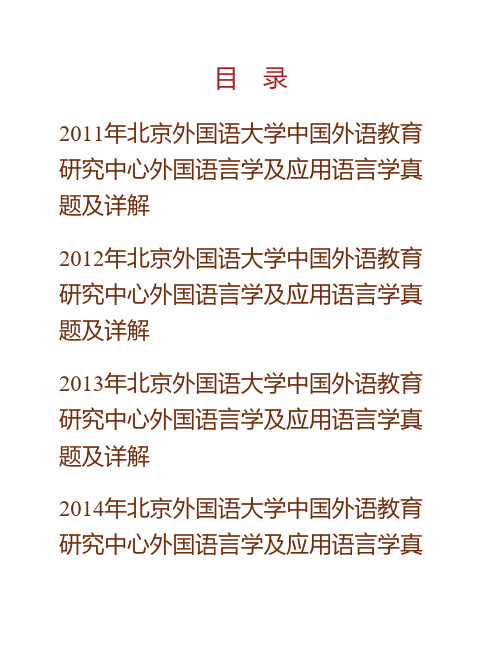
目 录2011年北京外国语大学中国外语教育研究中心外国语言学及应用语言学真题及详解2012年北京外国语大学中国外语教育研究中心外国语言学及应用语言学真题及详解2013年北京外国语大学中国外语教育研究中心外国语言学及应用语言学真题及详解2014年北京外国语大学中国外语教育研究中心外国语言学及应用语言学真题及详解2015年北京外国语大学中国外语教育研究中心外国语言学及应用语言学真题及详解2011年北京外国语大学中国外语教育研究中心外国语言学及应用语言学真题及详解I. Briefly explain the following terms. (20 points)1.perlocutionary act【答案】According to Austin, a speaker might be performing three acts simultaneously when speaking: locutionary act illocutionary act perlocutionary act. A perlocutionary act is the effect of the utterance. Thus, by saying “Morning!” the speaker has made it clear that he wants to keep friendly relations with the hearer.2.minimal pair【答案】Minimal pairs are the two words which are identical in every way except for one sound segment that occurs in the same place in the string. For example, the English words bear and pear constitute a minimal pair as they differ in meaning and in their initial phonemes /b/ and /p/.3.distinctive feature【答案】The distinctive feature refers to a property which distinguishes one phoneme from another. For example, “voicing” is a distinctive feature, since it plays an important role in distinguishing obstruents in English.4.linguistic variable【答案】Linguistic variable are those where the meaning remain constant but form varies like cat and pussy have the same social meaning but different form. So far pronunciation is concerned house [h] and with [h] has same social meaning with different pronunciation. Here variables are just the tools to analyze the language to set social dimensional society.5.lingua franca【答案】It is a language that is used for communication between different groups of people, each speaking a different language. The lingua franca couldbe an internationally used language of communication (e. g. English), it could be the native language of one of the groups, or it could be a language which is not spoken natively by any of the groups but has a simplified sentence structure and vocabulary and is often a mixture of two or more languages.II. Answer the following questions. (30 points)1.Why do we say linguistics is a science? (10 points)【答案】Linguistics is generally defined as the scientific study of language. It tries to answer the basic questions “What is language?” and “How does language work?” Linguistics studies not any particular language, e.g. English, Chinese, Arabic, and Latin, but it studies languages in general.It is a scientific study because it is based on the systematic investigation of linguistic data, conducted with reference to some general theory of language structure. In order to discover the nature and rules of the underlying language system, what the linguist has to do first is to collect and observe language facts, which arc found to display some similarities, and generalizations are made about them; then he formulates some hypotheses about the language structure. But the hypotheses thus formed have to be checked repeatedly against the observed facts to fully prove their validity. In linguistics, as in any other discipline, data and theory stand in a dialectical complementation; that is, a theory without the support of data can hardly claim validity, and data without being explained by some theory remain a muddled mass of things.(此题考查语言学作为一门学科其科学性,此题开放性试题,从其研究内容及方法角度作答即可。
英语专业语言学考研真题分析【圣才出品】
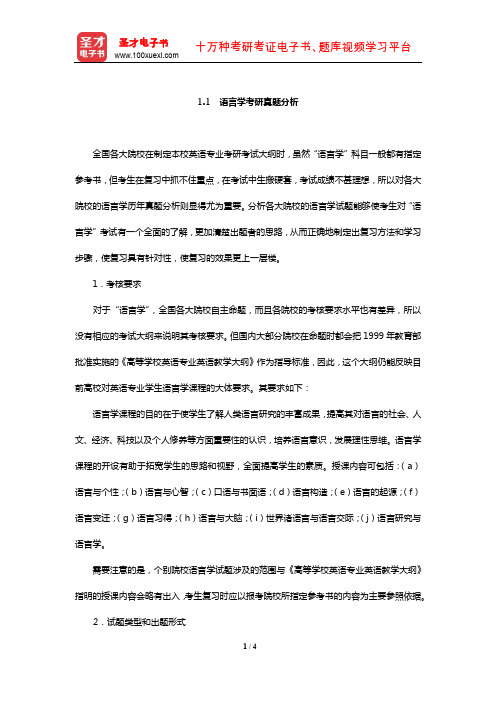
1.1 语言学考研真题分析全国各大院校在制定本校英语专业考研考试大纲时,虽然“语言学”科目一般都有指定参考书,但考生在复习中抓不住重点,在考试中生搬硬套,考试成绩不甚理想,所以对各大院校的语言学历年真题分析则显得尤为重要。
分析各大院校的语言学试题能够使考生对“语言学”考试有一个全面的了解,更加清楚出题者的思路,从而正确地制定出复习方法和学习步骤,使复习具有针对性,使复习的效果更上一层楼。
1.考核要求对于“语言学”,全国各大院校自主命题,而且各院校的考核要求水平也有差异,所以没有相应的考试大纲来说明其考核要求。
但国内大部分院校在命题时都会把1999年教育部批准实施的《高等学校英语专业英语教学大纲》作为指导标准,因此,这个大纲仍能反映目前高校对英语专业学生语言学课程的大体要求。
其要求如下:语言学课程的目的在于使学生了解人类语言研究的丰富成果,提高其对语言的社会、人文、经济、科技以及个人修养等方面重要性的认识,培养语言意识,发展理性思维。
语言学课程的开设有助于拓宽学生的思路和视野,全面提高学生的素质。
授课内容可包括:(a)语言与个性;(b)语言与心智;(c)口语与书面语;(d)语言构造;(e)语言的起源;(f)语言变迁;(g)语言习得;(h)语言与大脑;(i)世界诸语言与语言交际;(j)语言研究与语言学。
需要注意的是,个别院校语言学试题涉及的范围与《高等学校英语专业英语教学大纲》指明的授课内容会略有出入,考生复习时应以报考院校所指定参考书的内容为主要参照依据。
2.试题类型和出题形式通过分析全国众多院校“语言学”的历年真题,其题目类型大致包括选择题、判断正误题、填空题、术语解释题、音标题、问答题、翻译及写作等,具体归纳如下:(1)选择题选择题出题形式一般为一个留有空白的英文句子,要求考生从所给的四个选项选出正确答案。
如:According to ______ theory, grammar refers to the initial state of the human language faculty.A. Saussure’sB. Bloomfield’sC. Chomsky’sD. Halliday’s选择题考核的内容比较广泛,知识点也比较分散,采用这类题型的院校不多,有西安外国语大学、对外经济贸易大学等。
英语专业考研试题及答案
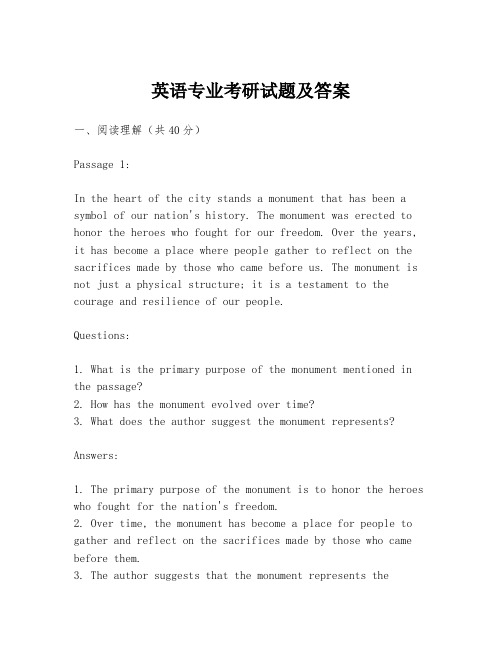
英语专业考研试题及答案一、阅读理解(共40分)Passage 1:In the heart of the city stands a monument that has been a symbol of our nation's history. The monument was erected to honor the heroes who fought for our freedom. Over the years, it has become a place where people gather to reflect on the sacrifices made by those who came before us. The monument is not just a physical structure; it is a testament to the courage and resilience of our people.Questions:1. What is the primary purpose of the monument mentioned in the passage?2. How has the monument evolved over time?3. What does the author suggest the monument represents?Answers:1. The primary purpose of the monument is to honor the heroes who fought for the nation's freedom.2. Over time, the monument has become a place for people to gather and reflect on the sacrifices made by those who came before them.3. The author suggests that the monument represents thecourage and resilience of the people.Passage 2:The advancement of technology has brought about significant changes in the way we communicate. With the advent of smartphones and social media, we are now more connected than ever before. However, this constant connectivity has also led to a paradoxical sense of isolation. While we can instantly reach out to others, we often find ourselves feeling more alone.Questions:1. What is the main topic of the passage?2. How has technology impacted our communication methods?3. What is the paradoxical effect of constant connectivity mentioned?Answers:1. The main topic of the passage is the impact of technology on communication and its paradoxical effects.2. Technology has made our communication methods more instant and widespread through smartphones and social media.3. The paradoxical effect is that despite being more connected, there is a sense of isolation and feeling more alone.二、完形填空(共20分)In recent years, the concept of a "work-life balance" has become increasingly important to many people. It refers to the idea of balancing one's work and personal life, ensuring that neither overshadows the other. However, achieving this balance is not always easy. Many individuals find themselves caught between the demands of their job and the needs oftheir family. Despite the challenges, it is crucial to find a balance to maintain overall well-being.Answers:1. balancing2. overshadows3. easy4. caught5. challenges三、翻译(共20分)英译汉:The beauty of nature is a source of inspiration for many artists. It provides a canvas for creativity and a backdrop for imagination.汉译英:随着科技的发展,我们的生活变得越来越便捷。
- 1、下载文档前请自行甄别文档内容的完整性,平台不提供额外的编辑、内容补充、找答案等附加服务。
- 2、"仅部分预览"的文档,不可在线预览部分如存在完整性等问题,可反馈申请退款(可完整预览的文档不适用该条件!)。
- 3、如文档侵犯您的权益,请联系客服反馈,我们会尽快为您处理(人工客服工作时间:9:00-18:30)。
英语语言学考研全国名校考研真题解析
第1章全国院校英语专业语言学考研真题分析
对于报考英语专业研究生的考生而言,“语言学”是全国各院校英语专业研究生入学考试专业课科目(一般而言,英语专业专业课分语言学、文学及翻译等三个研究方向)。
需要说明的是,有的院校会将研究方向与考试科目紧密挂钩,即报考语言学研究方向就只考语言学试题,报考英美文学方向就只考英美文学试题,语言学为单卷,分值为150分(如中国人民大学等);有的院校试卷考察内容会同时涉及文学、语言学、翻译等内容(有的院校涉及两部分),各占50分,满分150分(如南开大学等)。
1.1 语言学考研真题分析
全国各大院校在制定本校英语专业考研考试大纲时,虽然“语言学”科目一般都有指定参考书,但考生在复习中抓不住重点,在考试中生搬硬套,考试成绩不甚理想,所以对各大院校的语言学历年真题分析则显得尤为重要。
分析各大院校的语言学试题能够使考生对“语言学”考试有一个全面的了解,更加清楚出题者的思路,从而正确地制定出复习方法和学习步骤,使复习具有针对性,使复习的效果更上一层楼。
1.考核要求
对于“语言学”,全国各大院校自主命题,而且各院校的考核要求水平也有差异,所以没有相应的考试大纲来说明其考核要求。
但国内大部分院校在命题时都会把1999年教育部批准实施的《高等学校英语专业英语教学大纲》作为指导标准,因此,这个大纲仍能反映目前高校对英语专业学生语言学课程的大体要求。
其要求如下:
语言学课程的目的在于使学生了解人类语言研究的丰富成果,提高其对语言的社会、人文、经济、科技以及个人修养等方面重要性的认识,培养语言意识,发展理性思维。
语言学课程的开设有助于拓宽学生的思路和视野,全面提高学生的素质。
授课内容可包括:(a)语言与个性;(b)语言与心智;(c)口语与书面语;(d)语言构造;(e)语言的起源;(f)语言变迁;(g)语言习得;(h)语言与大脑;(i)世界诸语言与语言交际;(j)语言研究与语言学。
需要注意的是,个别院校语言学试题涉及的范围与《高等学校英语专业英语教学大纲》指明的授课内容会略有出入,考生复习时应以报考院校所指定参考书的内容为主要参照依据。
2.试题类型和出题形式
通过分析全国众多院校“语言学”的历年真题,其题目类型大致包括选择题、判断正误题、填空题、术语解释题、音标题、问答题、翻译及写作等,具体归纳如下:(1)选择题
选择题出题形式一般为一个留有空白的英文句子,要求考生从所给的四个选项选出正确答案。
如:
According to ______ theory, grammar refers to the initial state of the human language faculty.
A. Saussure’s
B. Bloomfield’s
C. Chomsky’s
D. Halliday’s
选择题考核的内容比较广泛,知识点也比较分散,采用这类题型的院校不多,有西安外国语大学、对外经济贸易大学等。
(2)判断正误题
判断正误题出题形式为题目给出一个句子,要求考生用T/F标明其正确与否,极个别院校(如武汉大学)还要求指明错误原因。
如:
The description of a language at some point in time is called diachronic study.
Key: F (diachronic study→synchronic study)
判断正误题比较常见,采用这类题型的院校有清华大学、北京第二外国语大学、对外经济贸易大学、武汉大学、上海外国语大学等。
(3)填空题
填空题出题形式为一个留有空白的英文句子,要求考生根据句中提供的信息填出正确的答案。
如:
According to G. Leech, ______ meaning refers to what is communicated of the feelings and attitudes of the speaker/writer. (affective)
采用这类题型的院校有北京第二外国语大学、清华大学、中国人民大学等。
(4)术语解释题
术语解释题出题形式为题目给出一个术语,要求考生对其进行解释,但个别院校对答题方式还有具体要求,或者要求只用一个句子解释(如四川大学),或者要求举例说明所解释的术语(如上海交通大学)。
如:
Define the following linguistic term with at least one appropriate example. Phoneme
Key: It refers to the abstract element of sound, identified as being distinctive in a particular language. For example, in English, /p/ is described as a phoneme.
术语解释题是很多院校都会采用的一种题型,如南开大学、上海交通大学、四川大学、武汉大学、浙江大学、中山大学等。
(5)音标题
音标题出题形式有两种,一种是题目给出单词,要求注明其音标,或是题目给出音标,要求描述其特征。
如:
Write the International Phonetic Alphabet for the following word advertisement: [ Ed5vE:tismEnt]
采用这类题型的院校有中山大学、南京大学等。
另一种是题目给出某个辅音或元音,要求描述其发音特征,或是题目给出某个发音特征,要求写出其对应音素。
如:
[f]: voiceless, labiodental, fricative
这种题型相对于前一种比较普遍,采用这类题型的院校有清华大学、南开大学、北京师范大学等。
(6)问答题
问答题出题形式主要有简述题(如对某个语言学术语、现象的解释和理解)、材料分析题(如分析句子的歧义,或题目给出一段对话,根据要求做相关分析)、论述题(题目给出一种观点,要求考生发表自己的看法)。
对于英语专业语言学考研试题,绝大多数院校都会采用这种题型,而且分值比重很大,如北京大学“专业知识”的语言学方向试题,一共5道问答题,每道30分。
(7)翻译题
对于语言学作为单科目的试卷,只有极少数院校会涉及到这种题型。
2006年南开大学外国语言学及应用语言学专业的“应用语言学”考试科目中,翻译题分别考了英译汉及汉译英两部分,各为40分,翻译题材跟语言学内容没有关联;2006年中国人民大学“专业英语”语言学方向试题中,翻译题为一篇英译汉段落,内容涉及语义学范畴。
(8)写作题
对于语言学作为单科目的试卷,只有极个别院校涉及到这种题型。
上海交通大学“外国语言学和应用语言学基础知识”考试科目,每年都会有50分的写作题型,如2012年写作的题目为My view on E-Textbook。
